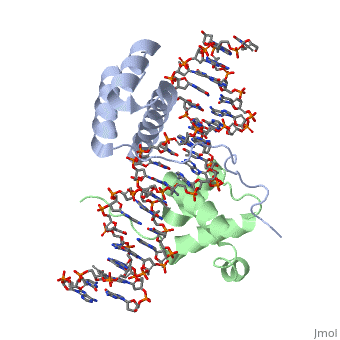Tyrone Evans Hox Proteins sandbox
From Proteopedia
(Difference between revisions)
| (7 intermediate revisions not shown.) | |||
| Line 4: | Line 4: | ||
== Introduction == | == Introduction == | ||
| - | Hox Proteins are transcription factors, proteins that are involved in the process of transcribing DNA into RNA. These specific types of proteins are capable of binding to enhancers, a short (50-1500 bp) region of DNA, in pursuit of activating or repressing certain genes. These proteins are named this way because of the mutations that are done within them that cause homeotic transformations, changing of an organ into another. | + | Hox Proteins are transcription factors, proteins that are involved in the process of transcribing DNA into RNA. These specific types of proteins are capable of binding to enhancers, a short (50-1500 bp) region of DNA, in pursuit of activating or repressing certain genes. These proteins are named this way because of the mutations that are done within them that cause homeotic transformations, changing of an organ into another<ref>"Hox Gene." Wikipedia. Wikimedia Foundation, 14 Aug. 2015. Web. 20 Oct. 2015.</ref> <ref>Ladam, Franck, and Charles G. Sagerström. “Hox Regulation of Transcription – More Complex(es).” Developmental dynamics : an official publication of the American Association of Anatomists 243.1 (2014): 10.1002/dvdy.23997. PMC. Web. 3 Nov. 2015.</ref> |
| + | . | ||
== Role in Development == | == Role in Development == | ||
| Line 17: | Line 18: | ||
== Interaction with DNA == | == Interaction with DNA == | ||
| - | A homeodomain is an essential part that all Hox proteins possess. The homeodomain can be found within the homeobox, a DNA sequence found within genes that are responsible of morphogenesis of living organisms. This sequence codes for homeodomain protein products, 60 amino-acid segments, which have specific folding patterns (helix-turn-helix) that allows them to bind with DNA through a <scene name='71/714951/Taaat_sequence/1'>5’-TAAAT-3’</scene> core motif. This domain | + | A homeodomain is an essential part that all Hox proteins possess. The homeodomain can be found within the homeobox, a DNA sequence found within genes that are responsible of morphogenesis of living organisms. This sequence codes for homeodomain protein products, 60 amino-acid segments, which have specific folding patterns (helix-turn-helix) that allows them to bind with DNA through a <scene name='71/714951/Taaat_sequence/1'>5’-TAAAT-3’</scene> core motif. This domain consists of three helical regions folded into a tight spherical structure. There are <scene name='71/714951/Both_n_and_c-terminal_helices/1'>two antiparallel N-terminal helices and one C-terminal helix</scene> (Recognition helix) within this domain. The C-terminal helix binds directly with DNA through the use of <scene name='71/714951/H_bond_between_gln_and_p/1'>Hydrogen bonds</scene> and <scene name='71/714951/Hydrophobic_interaction/3'>Hydrophobic interactions</scene> between side chains and the outer bases and thymine methyl groups within the major groove of a DNA helix. Ionic bonding can also be observed between the bases of the DNA sequence and the amino acids of the protein dimers. A more specific <scene name='71/714951/Ionic_bond/1'>Ionic interaction</scene> is the one between LYS 207 and an oxygen atom of a phosphate group. The <scene name='71/714951/Recognition_helix/1'>Recognition helix</scene> within homeodomain binds within the <scene name='71/714951/Dna_major_groove/1'>major groove</scene> of a DNA helix, while the <scene name='71/714951/Amino-terminal_tail/1'>Amino-Terminal tail</scene> binds within the <scene name='71/714951/Dna_minor_groove/1'>minor groove</scene> of a DNA helix<ref>"Hox Gene." Wikipedia. Wikimedia Foundation, 14 Aug. 2015. Web. 20 Oct. 2015.</ref>. |
== Human Hox Genes<ref>"Hox Gene." Wikipedia. Wikimedia Foundation, 14 Aug. 2015. Web. 20 Oct. 2015.</ref> == | == Human Hox Genes<ref>"Hox Gene." Wikipedia. Wikimedia Foundation, 14 Aug. 2015. Web. 20 Oct. 2015.</ref> == | ||
| Line 31: | Line 32: | ||
== Structural highlights<ref>Berman, Helen M., John Westbrook, Zukang Feng, Gary Gilliland, T. N. Bhat, Helge Weissig, Ilya N. Shindyalov, and Philip E. Bourne. "The Protein Data Bank." RCSB. Nucl. Acids Res. (2000) 28 (1): 235-242 Web.</ref> == | == Structural highlights<ref>Berman, Helen M., John Westbrook, Zukang Feng, Gary Gilliland, T. N. Bhat, Helge Weissig, Ilya N. Shindyalov, and Philip E. Bourne. "The Protein Data Bank." RCSB. Nucl. Acids Res. (2000) 28 (1): 235-242 Web.</ref> == | ||
<scene name='71/714951/Taaat_sequence/1'>5’-TAAT-3’</scene> | <scene name='71/714951/Taaat_sequence/1'>5’-TAAT-3’</scene> | ||
| + | |||
| + | <scene name='71/714951/Both_n_and_c-terminal_helices/1'>Two antiparallel N-terminal helices and one C-terminal helix</scene> | ||
<scene name='71/714951/H_bond_between_gln_and_p/1'>Hydrogen bonds</scene> | <scene name='71/714951/H_bond_between_gln_and_p/1'>Hydrogen bonds</scene> | ||
| Line 48: | Line 51: | ||
== References == | == References == | ||
<references/> | <references/> | ||
| - | Berman, Helen M., John Westbrook, Zukang Feng, Gary Gilliland, T. N. Bhat, Helge Weissig, Ilya N. Shindyalov, and Philip E. Bourne. "The Protein Data Bank." RCSB. Nucl. Acids Res. (2000) 28 (1): 235-242 Web.<ref>Berman, Helen M., John Westbrook, Zukang Feng, Gary Gilliland, T. N. Bhat, Helge Weissig, Ilya N. Shindyalov, and Philip E. Bourne. "The Protein Data Bank." RCSB. Nucl. Acids Res. (2000) 28 (1): 235-242 Web.</ref> | ||
| - | |||
| - | "Hox Gene." Wikipedia. Wikimedia Foundation, 14 Aug. 2015. Web. 20 Oct. 2015.<ref>"Hox Gene." Wikipedia. Wikimedia Foundation, 14 Aug. 2015. Web. 20 Oct. 2015.</ref> | ||
| - | |||
| - | Freeman, Quillin, and Allison. Biological Science. 5th ed. Vol. 1. N.p.: Benjamin Cummings, n.d. Print.<ref>Freeman, Quillin, and Allison. Biological Science. 5th ed. Vol. 1. N.p.: Benjamin Cummings, n.d. Print. | ||
| - | </ref> | ||
| - | |||
| - | Ladam, Franck, and Charles G. Sagerström. “Hox Regulation of Transcription – More Complex(es).” Developmental dynamics : an official publication of the American Association of Anatomists 243.1 (2014): 10.1002/dvdy.23997. PMC. Web. 3 Nov. 2015.<ref>Ladam, Franck, and Charles G. Sagerström. “Hox Regulation of Transcription – More Complex(es).” Developmental dynamics : an official publication of the American Association of Anatomists 243.1 (2014): 10.1002/dvdy.23997. PMC. Web. 3 Nov. 2015.</ref> | ||
Current revision
Hox Proteins
| |||||||||||

